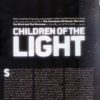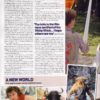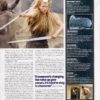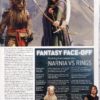Total Film Talks Narnia
Total Film Magazine has an excellent article containing conversations with Andrew Adamson, Tilda Swinton, James McAvoy, and the four children. Many thanks to Jints for scanning the article. You can also read our transcription of it below.
With an enchanting story, an icy, iconic villain, and the most charming child cast ever assembled, The Chronicles of Narnia: The Lion, the Witch, and the Wardrobe is, literally, out of this world.
Children of the Light
Sorry, sorry, sorry … this is the trouble when Oscar-winning filmmakers actually read what you write about them. In August this year, when Total Film delivered the world-exclusive first look at The Chronicles of Narnia, we suggested the similarities between the adaptations of CS Lewis’ vibrant fantasy novels and JRR Tolkien’s The Lord of the Ring didn’t stop with the friendship between the authors, fantastical creatures, huge popularity and generation-spanning appeal. There were the Kiwi directors. And their dress sense. Or, more pointedly, lack of it. Peter Jackson has yet to take us to task, but a few hours before we’re due to interview Narnia’s megaphone-wielder, Andrew Adamson, young Scottish star James McAvoy — aka nervous faun Mr Tumnus — delivers a warning: “You have to watch yourself. Andrew can just go …”
McAvoy’s pulling our leg, but he’s a good actor, so, for a moment, we’re concerned. Still, having seen the long-haired, laid-back Adamson in action — working with the Weta Workshop team (the effects crew who forged Rings) to define a unicorn’s horn; cueing up shots on a snow-bound Auckland set; talking us through scenes in the edit suite — it’s hard to imagine him getting really riled. Chat to Richard Taylor and he’ll tell you the director “really pushed us at an artistic level”, but — perched on the blustery Flock Hill, location of the spectacular final battle on New Zealand’s luscious South Island — there isn’t a trace of bitterness below the Weta honcho’s red and blue woollen hat. “You want to be pushed!” he says. “You hope something will influence you to be better and we’ve had that in spades on this project.”
And Adamson? He can’t stop laughing. “I was like, ‘Who is this guy? And what was he wearing?'” he says, recalling reading Total Film. “But it was my wife who was upset, because I happened to be wearing clothes she had bought for me that day! But I definitely wasn’t offended by it and thought it was actually very funny. I’m certainly not known for my choice of wardrobe, either … Apart from The Lion, the Witch, and the Wardrobe.”
For a man who has a $100 million potential franchise-starter mere weeks from release (and a two-week old baby to care for), Adamson is remarkably relaxed. The edit is complete and he’s working on the visual effects, locking the score and overseeing the colour-timing (whatever the hell that is). At this point in any project, let alone a blockbuster adaptation of a hugely popular series, most directors talk through gritted teeth and can’t wait to be done with the damn thing. But the Shrek helmer appears thrilled with how his first live-action gig is working out.
“The nice thing at this point is every time you watch it, it gets a little bit better — the sound effects are on it or the real music’s in. And I’ve shown the movie to enough people, including CS Lewis’ stepson, Douglas Gresham, that I’m confident it represents the book well and fans will like it — which was a big concern, going in. I’m lucky we shot in New Zealand, because it’s hard to find people there who haven’t read the book and often people would walk onto the set and say, ‘Oh, this is exactly how I imagined it!’ That was the challenge with CS Lewis, because he left a lot to the imagination, he didn’t define things as much as Tolkien.”
The challenge for Weta was even greater than on Rings; for Middle-earth, they had to design and craft a mere ten species. For Narnia, 60. Look around their buzzing workshop and it’s quite a scene: rows of swords, stacks of helmets, a minotaur hefting a great axe and growling in the corner …
“The thing about Weta is they take so much care,” says Georgie Henley. “They took such care. It was like real Narnian weapons and finery. My dagger was amazing, and so was my vial. It’s just the little details — like my little vial had an Aslan stopper — that finished off the whole design.” Henley is ten. And while it’s perhaps a little patronising to assume all ten year olds should be tongue-tied tweens cowed by talking to the press, it’s still shocking how erudite and bright the kid is. She plays Lucy Pevensie, the sprog who first steps through the magic wardrobe in war-torn England into Narnia’s enchanted snowscape. Edmund (Skandar Keynes) follows her, but refuses to confirm to sceptical older siblings Susan (Anna Popplewell) and Peter (William Moseley) the existence of the new world. The two needle each other mildly in real life too.
“Andrew would sometimes play the animals,” says Henley, of shooting against a green screen and imagining the mythological creatures she was acting with. “Or he would look about like a great huge golden lion … He looks a bit like a lion himself!” Skandar has an alternate view: “He’s a bit of a hippy…” “He’s not a hippy!” “He is a hippy!” Pause. Georgie stares. Skandar cracks. “Okay, I’m sorry I said anything …”
It’s the cliche of a thousand oh-so-happy film sets that everyone gets along just swell, just like a “family”. Only here, it feels nothing like an affectation. Adamson sat through 2500 audition tapes and workshopped with 800 young actors before settling on the four Pevensie children and their dynamic is perfect.
“We were a little bit typecast,” says Moseley, a fresh-faced 18 year old. “Anna’s the oldest in her family, I’m the oldest in mine, Georgie’s the youngest and Skandar’s the youngest and so …” “…we all slotted into those positions fairly easily,” finished Popplewell.
“I could say to Skandar, ‘Shut up! No more Coke for today!’ quite openly,” Moseley offers. “That’s why in truth the scenes work, because we trust each other as a family.”
“There was a moment when Skandar and Will were doing a scene at the beginning of the film,” recalls Henley, and they were really hating each other and they started to play fight and me and Anna got quite affected by it.”
Moseley: ‘There was an element of trust between us. That’s acting: you just have to trust that person with your emotions and they trust you with theirs. And that happened with us; we could say whatever we wanted in that moment.”
Keynes: “You were in the moment and you felt no … What’s the word? … We were learning about it in Drama …”
Moseley laughs. “It’s like Stanislavsky’s Method of acting!”
Keynes: “I’m going to kick myself later.”
There may not have been Stanislavsky’s Method on Narnia, but there was certainly Adamson’s. As McAvoy recalls, “We spent two weeks defining my walk!”
“It’s true,” admits the director. “We thought about it a lot. We decided standing on such tiny hooves would be like standing on stilts, you keep moving to maintain your balance, and James did some subtle things with head movements and things like that. He’s an incredible actor.”
The director also ensured that the first time Henley saw McAvoy in character, as half-man, half-goat creature Mr Tumnus, the camera was rolling. “He did a similar thing with Tilda,” says McAvoy. “He made sure the kids didn’t see her much off set, certainly not in costume or character, until they finally met her in the film … I hope the kids find her as terrifying as the kids in the film actually did, because they were all a bit kind of freaked out by her at first.”
Adamson also knew the best way to unnerve his young charges, when the drama called for it. “Skandar will bust me for telling you this,” he says, laughing, but the first scene where Edmund meets the Witch, I would tease him as he was getting into the sleigh: “Snuggle up to your new girlfriend!” And he would immediately start squirming, which gave us these great uncomfortable moments on camera, because he was at that age where he didn’t like the idea of girlfriends and the thought that I was telling him to treat this intimidating, tall woman as his girlfriend … Ha!” (Skandar is now having to get used to female attention, though not quite how he may have hoped. “The other day we were in Teen Vogue and this girl came running up to me, saying ‘Skandar, Skandar, you’re in Teen Vogue!’ And I’m playing it cool, like, ‘Yeah, yeah, that’s me’ and she goes, ‘So you must know Will!'”)
“Tilda was absolutely awesome,” says Popplewell, “in that you are in awe of her.” “One wonders where she gets this from,” adds Moseley. “She is so powerful. She has this energy, this walk and this movement, that is totally captivating.” Frankly, Total Film is a little scared of her too. Muse of the late avant garde artist/filmmaker Derek Jarman, star of Orlando and Young Adam, Swinton has had thousands of words expended upon trying to define her face: a task as thankless as trying to freeze sparks. It seems rather a laboured adjective in this context, but there is something bewitching about her. Photographer friend Johnnie Shand Kydd recently described snapping her, to The Observer: “Even if you hold the camera in exactly the same way, every frame is different.” Ten-year-old Georgie unconsciously mirrors the thought: “The thing about Tilda is she’s got the look of someone who can be so amazingly wonderful in a scene, but then so, like, you know, just normal …”
Normal is how Tilda feels when she’s talking to Total Film, ensconced with her family at home in Scotland having just returned from a trip to America. “I’m covered in children!” she says. “I’m not complaining, but it’s extraordinary how little time there is …” Her kids aren’t interested in watching The Lion, the Witch, and the Wardrobe. They fell asleep during the only one of her films they’ve ever attempted to watch, Orlando (“excellent criticism from the young ones early on!”), and the six-month shoot in New Zealand took her away from home for long stretches. Now she’s back and time is taken up “washing toy lions …” Toy Aslans! “Yeah, it occurred to me it was a good thing to be doing …”
Swinton is disarmingly frank. Adamson is keeping his personal spiritual beliefs under wraps, presumably to steer clear from either praise or condemnation from Christian groups or atheistic critics (as well as being a best-selling novelist, CS Lewis was one of the 20th-century’s finest theologians and his fictional work, like Tolkien’s, called on thematic strands from the Gospels), but his star has no such qualms. “Oh, I’ve no interest in any of that,” she says. “It’s not been made by evangelists; I’m in it, for goodness sake!”
Unlike McAvoy, the director or the child actors, Swinton wasn’t familiar with the books before being cast. And she was never convinced of the merit of keeping her distance from her young co-stars during the shoot. “There was this rather fanciful idea that it would be able to last any longer than one take …” She laughs. “But it sort of fell apart really quickly, with my help I have to say. I mean, how do you stay in character when someone’s changing the lead on the mike up your corset? What are you supposed to do, just turn them to stone? I don’t think it would have been much fun, and I’m really not very good at acting, so I don’t think I would have been able to keep it up for very long. But I had a very big dress, so that kind of kept people at bay …”
She did spend considerable time with Adamson talking through the history of the character (who appears in one other of Lewis’ seven Narnia books, prequel The Magician’s Nephew — “I really hope they make that because it’s a real riot”) and discussing how to avoid Evil Women In Film cliches. Since The Lion, the Witch, and the Wardrobe’s publication in 1950, The White Witch, Jadis, has become something of an iconic figure of evil — “the inspiration for many stereotypes” — and Swinton wanted to go back to the original. “She’s not the cliched harrumphing stage villain, but she’s also not human, so that gives you great freedom. She needs to be really frightening for the children and children don’t really get frightened by rage, they get frightened by coldness …”
Unpredictability, too, she says, in which case her own kids have her pegged, as they’re playing havoc in the next room. They’ve put talcum powder on the freshly laundered lion. “I don’t know what they’re doing,” she says, before considering her role as the incarnation of all Evil…
“This doesn’t feel like much of a departure,” she says. “I feel as if I’ve been working in special effects films all my life. It all links up. I think Derek Jarman would have loved the idea of me playing The White Witch. It sort of figures, really. I feel like I’m always making fantasy films anyway.” And with that, The White Witch is off to clean the talcum powder out of Aslan’s hair.









